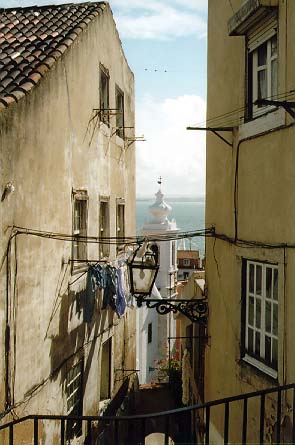 |
Lisbon is older than Rome—older, in fact, than any other western European capital. Situated on the inland side of the Tejo River's estuary lake, the city owes its initial growth and importance to its fortunate location overlooking an excellent and protected harbor. As long ago as the 12th-century BC, Phoenician sailors were attracted by the harbor to build the first settlement atop São Jorge, the highest part of what later became Lisbon. They called their settlement Alis Ubbo (Serene Harbor), from which the present name of the city derives.
The Romans took over from the Phoenicians after the Second Punic War in 201 BC and established Lisbon as the capital of their province of Lusitania. Various Germanic tribes, the most powerful being the Visigoths, followed the Romans and were themselves followed by the Moors who conquered Lisbon in 714 and held it for the next 400 years.
Determined to recapture Lisbon, Afonso Henriques, the first king of Portugal, enlisted knights on their way to the Second Holy Land Crusade with promises of spoils and land. In 1147 an army of Portuguese, English, Normans, Dutch, and Germans lay siege to Lisbon, which, with 20,000 families, was the second largest city in western Europe at the time. Four months into the siege, Afonso Henriques accepted the starving Moors' call for a truce but only as a ploy to overrun the city while its guard was down. A century later, under King Afonso III, Lisbon became Portugal's capital.
Lisbon's harbor became prominent again in the 16th century, when Portugal undertook its great voyages of discovery. Vasco da Gama sailed to India from Lisbon's Belém suburb in 1497, giving Portugal a virtual monopoly on eastern spices and ushering in a golden age for the whole country. For the next two centuries, comparatively tiny Lisbon enjoyed greater revenues than any other city in Europe.
In 1531 and again in 1597 severe tremors shook Lisbon, and in 1755 catastrophe finally struck while most of its citizens were collected in churches to celebrate All Saints' Day. The worst earthquake ever to hit a European city, it was felt as far away as Scotland and Jamaica. Citizens who ran to the open harbor to escape the fires that erupted throughout the city were swallowed by a tidal wave four stories high. In a few hours Lisbon lost between a quarter and a third of its population. One of the king's ministers, who later received the title of Marquis of Pombal, tore down the remains of Lisbon's damaged buildings and launched the first rational urban renewal in Europe.
A century later, in 1908, both the king and his heir were murdered by anti-monarchist bullets as their carriage pulled into the Praça do Comércio, which ironically Pombal had built in tribute to José I. Two years later, after a naval bombardment of Lisbon's palace, the monarchy met its demise.
In 1974, tanks with flowers in their guns rolled down Pombal's grand avenues to depose the government of the dictator António Salazar during Portugal's "Flower Revolution." The first act of the new revolutionary government was to liberate the Portuguese colonies of Angola, Mozambique, Guinea, and Cape Verde, which impacted Lisbon as greatly as the earthquake two centuries before. Portugal was forced to incorporate three quarters of a million retornados, people of Portuguese descent fleeing independent Africa for their official homeland. Its population swelled by ten percent in a matter of months, yet today Lisbon is still the smallest capital in western Europe. Its population stands at approximately 826,140.